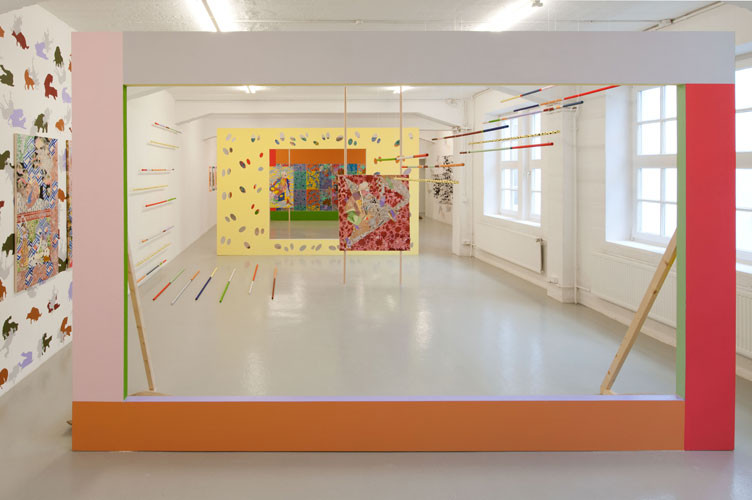Nadira Husain
28 Jun - 14 Sep 2014
NADIRA HUSAIN
Beugen Strecken
28 June - 14 September 2014
Our relation to images is conditioned by the various pictorial conventions of Western culture. Nadira Husain (born 1980 in Paris, lives and works in Paris and Berlin) addresses them in her work, albeit decidedly not from a traditional Western male perspective. Her generally figurative pictures display the influence of both Indian miniatures and the feminist theoretical apparatus. This atypical combination results on the one hand from an exploration of her own Indian roots as well as from her reflection about current social and political structures on the other.
In her first institutional solo exhibition titled BEUGEN STRECKEN [BEND STRETCH], the artist dismantles the classical articulation between frame and painting, motif and background. Picture and frame are accordingly no longer directly connected, visual elements are fragmented, ornament and main figure taken apart. The pattern’s proliferation and dissemination through the exhibition space dissolve the usual connections between wall, frame and image with the intent to reassemble these components within a different dynamic. Nadira Husain’s formal research reflects tension fields that are emerging within today’s society amid a desire to emancipate from traditions and the yearning for them.
Husain’s experiments with painting, drawing and print techniques are related with previous attempts to express subjectivities existing outside the Western male canon. In this sense the artist tries to eliminate the classical hierarchical structures at works in pictures—including the historical primacy of subject over decoration. Nadira Husain’s formal research reflects certain tension fields within today’s society that are emerging amid a desire to emancipate from traditions and the yearning for them.
Beugen Strecken
28 June - 14 September 2014
Our relation to images is conditioned by the various pictorial conventions of Western culture. Nadira Husain (born 1980 in Paris, lives and works in Paris and Berlin) addresses them in her work, albeit decidedly not from a traditional Western male perspective. Her generally figurative pictures display the influence of both Indian miniatures and the feminist theoretical apparatus. This atypical combination results on the one hand from an exploration of her own Indian roots as well as from her reflection about current social and political structures on the other.
In her first institutional solo exhibition titled BEUGEN STRECKEN [BEND STRETCH], the artist dismantles the classical articulation between frame and painting, motif and background. Picture and frame are accordingly no longer directly connected, visual elements are fragmented, ornament and main figure taken apart. The pattern’s proliferation and dissemination through the exhibition space dissolve the usual connections between wall, frame and image with the intent to reassemble these components within a different dynamic. Nadira Husain’s formal research reflects tension fields that are emerging within today’s society amid a desire to emancipate from traditions and the yearning for them.
Husain’s experiments with painting, drawing and print techniques are related with previous attempts to express subjectivities existing outside the Western male canon. In this sense the artist tries to eliminate the classical hierarchical structures at works in pictures—including the historical primacy of subject over decoration. Nadira Husain’s formal research reflects certain tension fields within today’s society that are emerging amid a desire to emancipate from traditions and the yearning for them.

